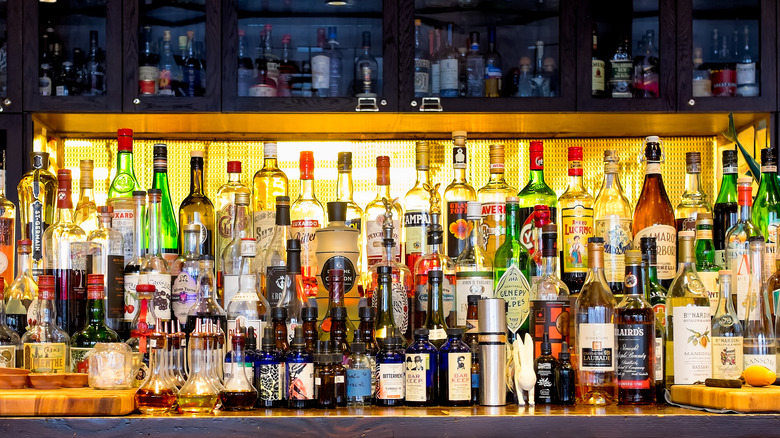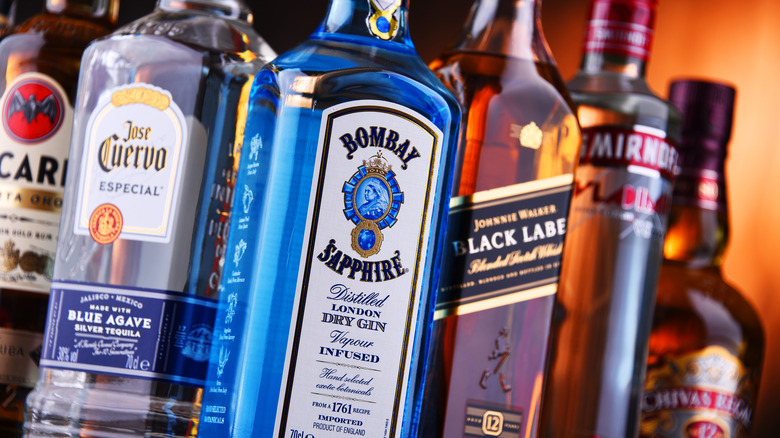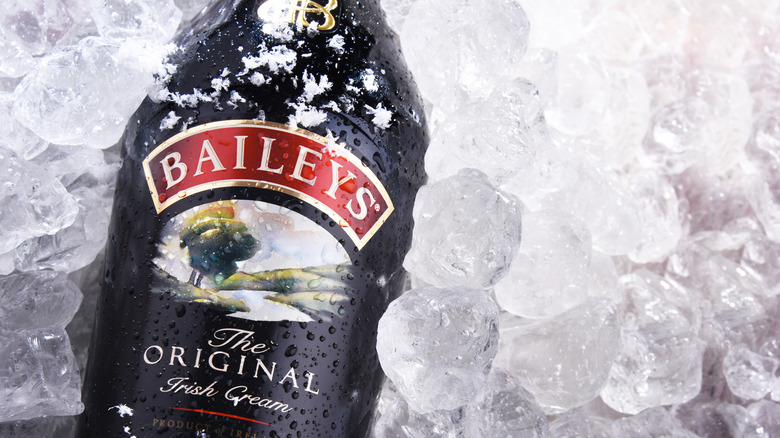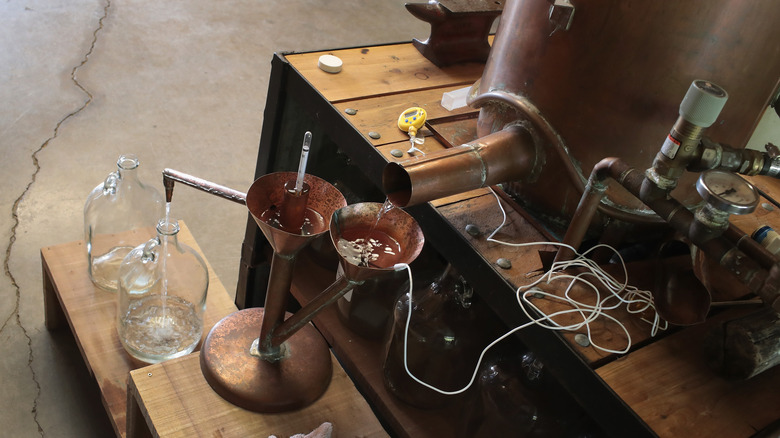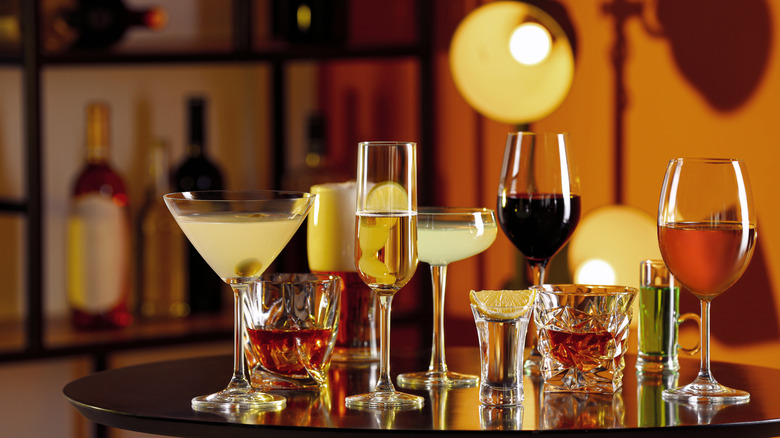Liquor Vs. Liqueur: What's The Difference?
It's been a long day, and you're ready to sit down and relax with a nice drink. Do you head to your fridge to grab an ice-cold beer, one of the newly popular hard seltzers, or do you uncork a bottle of red wine and pour yourself a glass? Or maybe, just for tonight, you're looking for something just a bit stronger, so it's off to the liquor store you go, where the aisles are lined with dozens of colorful bottles of booze. There are your classic liquors, like vodka and rum, as well as fancy-looking liqueurs, and being faced with all of them at once might leave you wondering what the difference between the two nearly phonetically identical types of drinks is in the first place.
The quick and obvious answer to your inquiry? Taste. Liqueurs tend to be sugary in flavor while liquor is made sans the sweet stuff and generally seen as tougher to swallow. But there's a bit more that distinguishes one from the other, like their flavor profiles and the actual amount of alcohol in each, all of which are important to keep in mind when crafting your post-work cocktail. Here's what you need to know to help make the perfect drink.
What is liquor?
Simply put, liquor is a distilled beverage. Also often referred to as "spirits," this kind of booze has a grain or plant at its base that is fermented and distilled to create one of the six classic types: brandy, gin, rum, tequila, whiskey, and vodka — none of which are particularly sweet to the taste.
Vodka was the first liquor to be stocked in the cabinet. According to Home Wet Bar, it has origins that date as far back as 8th-century Poland, where it was used for medicinal purposes rather than getting a buzz. Brandy came next in 1313, per The Brandy Bar, followed by whiskey, tequila, gin, and finally rum in the 1700s. Each tastes different depending on what's at its base — rum, for example, gets a hint of sweetness from sugarcane, while grain-based whiskey is a bit heartier. Different liquors may also contain different percentages of alcohol by volume (aka the strength of the drink), though most typically hover somewhere around 40%.
Liquors can also come in different flavors like citrus, cinnamon, and even whipped cream. While this does mean the addition of some sugar, it's not nearly as much as what goes into liqueur, so don't expect something exceptionally flavorful if gulping down a shot of one of these.
What is a liqueur?
Technically, all liqueurs are liquors, as they go through the same fermenting and distillation process which creates your favorite spirits (more on that in a bit). The liquor acts as a base for liqueurs, which are pumped full of additives to give them a more palatable flavor and (usually) a lower ABV.
Like many liquors, their sweetened counterparts — sometimes referred to as cordials — were said to have medicinal properties at their conception. Take Chartreuse, a naturally green liqueur that the Oxford Wine Company says was gifted to a group of monks in France by Francois Hannibal d'Estrees in 1605 with the promise of being "an elixir of long life." The beverage is still around — albeit a less potent version. Liqueurs can take on a wide range of flavors, and can even be cream-based. Easily drank straight (if you're into that sort of thing), liqueurs are most often employed by bartenders in addition to liquor to make cocktails even more delectable.
Here's what goes into making your favorite spirits and cordials
As previously mentioned, all liqueurs can be classified as liquors, so both types of booze undergo many of the same steps when being made. The deed starts with fermentation, a biological process that converts sugar into alcohol and carbon dioxide (via Liquor.com). According to Home Wet Bar, this method has been utilized as far back as 6500 B.C. to make mead, and was used for wine and beer soon after. However, unlike these older, less potent libations, liquors are then run through a still during the distillation process. The Cocktail Novice explains that this is what separates the water and other undesirable ingredients from the alcohol, ultimately strengthening the drink. The more times a drink is distilled, the higher the ABV.
Here's where things between liquor and liqueur start to differ. Following distillation some liquors (such as vodka and gin) are ready to be consumed, while others (like whiskey) are sent off to be aged. Meanwhile, other liquors are transformed into liqueurs through the addition of sweeteners, oils, and extracts. Concocting them is actually fairly straightforward and can even be done at home. The process for basic liqueurs (like Giada De Laurentiis' limoncello) simply requires a base of your favorite spirit and enough of the flavoring agent of your choice to give the drink its taste.
What types of drinks use liquor, liqueur, or both?
Remember that after-work cocktail you wanted? Well, now that you know the differences between liquor and liqueur, and you have purchased a few of each, it's time to head back home and figure out what to do with them. Of course, the easiest thing to do would be to throw back a shot of whatever you've picked up or to pour a bit in a glass with ice to enjoy. Most spirits can also be mixed together with any juice or soda you have sitting in your refrigerator, while certain liqueurs, like Bailey's, can even be added to hot chocolate or a dish of ice cream for a sweet and boozy treat to end your day.
If you are looking to get even fancier, there are plenty of cocktails that employ both spirits and cordials for a beverage that might even make you forget you're drinking the hard stuff in the first place. A margarita is an easy and classic example of a drink that combines lime juice with both a liquor (tequila) and liqueur (triple sec), as is a sidecar, which lists brandy, orange liqueur, and lemon juice as its ingredients. The Colorado Bulldog is another fun option, combining Kahula, vodka, cream, and Coke. The two varieties of booze can also be layered on top of each other for some extra festive shooters or full-sized drinks. How fun!
